Last reply was 13 years, 15 days ago.
The Fall 2011 Anime Preview Guide
Carl Kimlinger
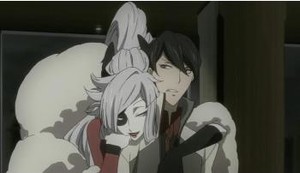
Un-Go
Rating: 3 ½
Review: No season would be complete without a mystery series. Un-Go, our entry this time, is backed up with a lot of creative muscle but has yet to really show what it can do. As anyone who's seen a mystery or two knows, parties and murder go hand in hand. So when disgraced financier Kaoru Kanou throws a period-themed ball, and invites two famous detectives no less, you know someone's going to die. The detectives are Rinroku Kaishou and Shinjurou Yuuki. Kaishou prefers to stay at home with his computers and their network of cameras, so he sends his daughter Rie instead. Yuuki, known far and wide as the Defeated Detective for his habit of hoofing it to crimes only to be shown up by the sedentary Kaishou, shows up in person accompanied by his bizarre assistant Inga. When Kanou ends up with a knife in his back, young Rie learns that neither crimes nor those who solve them are as simple as they first seem.
Because this episode's mystery had to be horned in between all of the introductory material required by a first episode, it's hard to say yet how Un-Go will fare on the deductive front. Kanou's murder has the requisite red herrings and twists, but it plays out too quickly for us to properly match wits with the screenwriters, so ultimate judgment will have to wait for future mysteries. There's no waiting necessary to appreciate the series' idiosyncratic look though, nor its breakneck pacing. Stylish to fault and livelier than most of its peers put together, the show is never less than fun to look at, or to watch. The interesting dynamic between Yuuki and Kaishou helps with the watching, as does the touch of lightness that Rie and her entourage bring to the proceedings. For those who like such things, the series also has a complicated setting (post-war future Japan) as well as a supernatural enigma in the form of the creepy, mid-controlling, shape-shifting Inga. For now, that's enough, but if the show's going to have any staying power, it needs to get working on those mysteries.
Un-Go is available streaming at Crunchyroll.
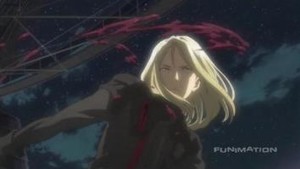
Guilty Crown
Rating: 4
Review: If there's anything Tetsuro Araki, director of Production I.G.'s newest sci-fi spectacular, is good at, it's action. Even if you were so tired of zombies that watching it made you feel like one yourself, the one thing you couldn't deny about Highschool of the Dead is that it kicked monstrous ass. Ditto the confused Kurozuka and even Death Note, whose fights were mental but dynamic and exciting nonetheless. Guilty Crown allows Araki to unleash that action beast, without giving him a chance to indulge in the self-conscious edginess that so often accompanies it. In so doing, it becomes one of his more enjoyable works to date.
The story takes place in the future, after a plague has ripped through Japan and forced it to live under the control of a multinational "relief" force known as the GHQ. Shu Ouma is a high school student in this future. He's pretty normal, if reserved and maybe harder on himself than he should be. That is set to change, beginning with the theft of a top-secret...something from GHQ. Injured, the girl who stole it takes refuge in a run-down room that Shu uses to edit videos. When GHQ thugs come for her, Shu knuckles under like a good sheep. Disgusted with himself, he takes the...something to its intended destination.
Whereupon he hooks up with some anti-GHQ guerillas and all hell breaks loose. Swords are pulled suggestively from nubile youngsters and bloody fragments of repressed memory come into it, as do genocidal mecha and one badass, flowing-haired prince. It's pretty conventional (wake up and smell the wish fulfillment!), more than a tad predictable, and pretty much awesome from start to finish. That has something to do with screenwriter Hiroyuki Yoshino, who has long experience with turning tired premises awesome (My-HiME anyone?), and everything to do with Araki. The episode's final minutes are a lesson in cinematic excess, filled with odd angles, dizzying camerawork, and slicker-than-greased-lawyers animation of glowing energies, slashing swords, burning cities, flying fists and exploding mecha. Before you watch, get a stick; you'll need it to prop your jaw back up.
Guilty Crown is available streaming at Funimation.com.

Horizon in the Middle of Nowhere Episode 2
Rating: 2 ½
Review: Horizon sets about the business of clearing up episode one's log-jam of information, but the new clarity doesn't actually improve the series much. What improvement there is comes from a more unexpected source: the characters. The city-ship Musashi continues its trip to Mikawa, one-time home of Musashi Ariadust Academy student council vice-president Masazumi Honda. Masazumi has a complicated history with the place, and so has complicated feelings about returning. Before doing so, she visits her mother's grave, where she discusses her past with P-01s, the android waitress at her favorite restaurant. In the meantime Student Council President and giant idiot Tori Aoi is beginning preparations for his big confession, which naturally includes throwing a party and groping someone with a similar bust to his beloved.
A lot of what was just sort of thrown into the ring during episode one gets a proper explanation here, but the explanations are neither gracefully presented nor terribly satisfying. A good deal of the information is dumped into our laps during a history lesson at the Academy and most of the rest is gleaned from half-helpful remarks by supporting players. What we learn is a load of pseudoscientific gobbledygook about alternate planes collapsing together and a plan to reclaim humanity's place in the Heavens by re-enacting the steps that had originally gotten them there (i.e. history). The Testament Plan and Harmonic Divine States are indeed explained by such things, but they still don't make much objective sense.
Of far more benefit is the episode's narrower focus, which zeroes in on Masazumi (who was nothing but a name last episode) and Tori. Masazumi proves to be a grave, sweet, intersexed person (the female pronoun is a convenience) with big ambitions and the drive to pursue them regardless of her financial or social status. She's a strange but very effective choice for a lead character. As is Tori. Lazy, dippy, unkillably optimistic and perpetually perverted, he's like Captain Tylor on libido pills. There's plot aplenty—too plenty—and Tori will eventually need to show some depth of character, but it is to follow him and Masazumi, and perhaps others as well, that we'll be following Horizon. If at all.
Horizon in the Middle of Nowhere is available streaming at The Anime Network
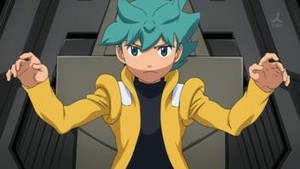
Mobile Suit Gundam Age
Rating: 3
Review: There's nothing wrong with a new Gundam universe; the franchise reboots itself more often than your average computer. There's nothing wrong with a new Gundam universe aimed at a younger demographic. There is something wrong, however, with turning the franchise's usual all-too-human antagonists into faceless mechanical monsters. A boy named Flit is the Gundam pilot-to-be this time around. The heir to a storied family of machine manufacturers, he's orphaned when mysterious attackers raze his home colony to the ground. He devotes the subsequent years to recreating his family's greatest machine, the near-mythical Gundam, in preparation for the time when the mysterious attackers return. When they do, they take his new colony's defenders by complete surprise. The conventional forces are quickly subdued, leaving no one but Flit to pilot his experimental mobile suit. Which he does; and well, as it turns out.
There are several things that tell you that Gundam Age is being pitched at a younger audience. The kiddie designs are probably the most obvious, but there's also the young lead and the overall feel of the series, which is more GaoGaiGar than Gundam Seed. The political aspect has been toned down (for now at least), and the characters fit into traditional super-robot roles easier than they do traditional Gundam roles. There's the wacky professor, the grave and dignified military commander, the sensible girl friend, and of course, the fiery young pilot. This is also where the faceless monsters come in. While they're unusual for a Gundam series, they'd be right at home in GaoGaiGar. They even have an amusingly generic name and a convenient acronym (Unidentified Enemy, or UE). The problem is that the franchise's customary moral conflict disappears with their appearance. After all, why would Flit feel conflicted about killing monsters?
You shouldn't count Gundam Age out just yet, though. It's a common Gundam ploy to start out simple and increase in scale and complexity as one goes. Already there are signs that the UE aren't the simple engines of destruction they first seemed, and the series has plans to span three generations of pilots. Three generations. That's plenty of time for things to get complicated.

Kimi to Boku. Episode 2
Rating: 3 ½
Review: It's normal for a series to improve as its characters grow on us, but not this much. Kimi to Boku's first episode was ho-hum; it's second is sweet and fun and just a little touching. There's more going on here than the cast just growing on us. This is honest-to-goodness improvement. Yuta, Yuki, Kaname and Shun's world is expanding, and the change is nothing but good. When the rest of the gang is late for the quartet's usual rooftop lunch, Shun has a run-in with a tiny little slip of girl with a scraped knee. He offers her a band-aid, but oddly enough has to chase her down to get her to accept it. Proving the old adage that no good deed goes unpunished, the girl inexplicably starts waging a war of annoyance on Shun. She pranks him nonstop, until even Kaname and the gang are dragged in.
The addition of Masaki, the girl in question, gives this episode a cohesiveness that the somewhat rambling first episode lacked. As a result it's more consistent, maintaining a decent level of humor throughout (Masaki's petty reign of terror is particularly amusing)
and delivering an actual payoff at the end. It has a wider emotional palette than before, injecting some wistfulness, a hint of romance, and even a tiny pang of pain into the series' now-habitual laid-back sweetness. And the cast does grow on us as well. Since it revolves around him, the episode is particularly kind to Shun, but Yuta also benefits, betraying the compassion and insight that his bluntness usually disguises. How well-written these characters are comes as something of a surprise. Masaki, though only one episode old, is already fully-realized and ready to put the loveableness back in tsunderes. It's the revelation of her motives that gives this episode its heart, and its kick, as well as its proof of intelligence. Her motives fit into the episode's events so perfectly (pay attention to the timing of the onset of her prank-war) that they can't be the product of anything but real, live smarts. Oh, the horror.
Kimi to Boku. is available streaming at Crunchyroll.

Mirai Nikki
Rating: 2
Review: Interesting Idea, meet Uninteresting Execution. Uninteresting Execution, meet Interesting Idea. Treat each other well, since you'll be roomies from now on. A diary that tells the future; that's the idea. Amano, our hero, is given one by Deus ex Machina, a god that he created in his head. It's just like the one that he keeps on his cell phone, the one he writes non-stop as a way of keeping the world at bay. Except it tells what's going to happen instead of recording what already has. At first Amano uses it to do the usual stuff you'd expect a teen to do: cheat on tests, dodge bullies, feel superior to everyone else. But that changes when it becomes obvious that Deus has been spreading the future-predicting love. For one, to seemingly perfect classmate Yuno, but more problematically, to a masked serial killer know only as Third. When Third comes after Amano, he must use his diary to kill—something he should probably get used to, as Deus has fashioned the diaries into a "survival game" from which only one diarist can emerge alive.
What would you do with a future diary? Who cares? You're never getting one. The more pertinent question might be what you would do with a TV series about a future diary. I give even odds that, whatever you think up, it would be more interesting than some supernatural retread of Battle Royale. Arbitrary parameters (everyone loves rules!), a morbid fascination with human ugliness, a videogame plot structure—this is a mighty poor way to treat a promising idea. It's unimaginative, it's tired, and it's straight-jacketed from the outset by its premise and self-imposed rules. It also features nothing but unpleasant people—aside from self-absorbed Amano, the only characters are a psychotic stalker, a manipulative god, and a serial killer—and is positively drenched in that grey, washed-out aura of anomie so popular these days. It's nice that the series acknowledges free will (it didn't have to; check out Death Note) and, though glossed over, the idea of a god stepping out of the imagination that created him is fascinating stuff, but mostly Mirai Nikki is just a bleak, violent waste of time.
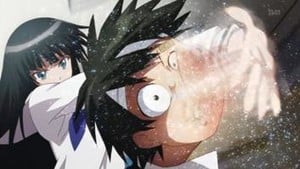
Ben-To
Rating: 4
Review: As they say, life is a battle. Some people take it too far, though. Yō Satō has just met some of them, though he doesn't know it yet. The reason he doesn't know it is because he's lying in a pool of blood, suffering from massive head trauma. He can't remember or even really imagine how he got mortally wounded in the middle of a supermarket. All he really knows is that he's really hungry. A cool-headed girl later warns him away from the store, and another, more excitable girl he meets on his way to school encourages him to go again, but it's his stomach that decides for him. He's hungry and darn if it isn't too annoying and expensive to cook for himself. So he heads to the store and, lucky him, the leftover bentos are being marked half-price just as he arrives. That's when he learns what happened the night before. Turns out, there are people who take half-price boxed lunches very seriously. And he just happened to get caught between their fists and their food.
This is a one very silly action series; maybe the silliest since Ramen Fighter Miki made delivering ramen an excuse to rumble. And that's okay, because it's also very funny. (The two aren't always the same, as anyone who sat through Kenichi the Mightiest Disciple can tell you.) The series is a reminder of just how rare and precious a grade-A sense of humor actually is. So much of what passes for funny is recycled and regurgitated that it's a genuine shock to be hit with a fresh gag, the way the Grand Canyon or an elephant is a shock after only seeing pictures of them. It isn't just the concept of street-fighting bento fans; it's the way Yō describes his life as it flashes before his eyes (he gives getting blown up as a toddler and being embarrassed by subway employees equal weight), the specific way that the class representative slaps him when she thinks he's moving in on her (female) crush. And it does it all without disrespecting the shows it pokes fun at or compromising its quality as an action series. Silly, funny, and good? Who'd have thought it?
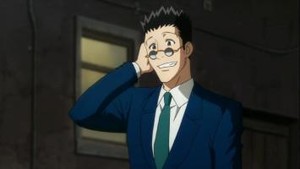
Hunter x Hunter Episode 2
Rating: 2 ½
Review: Some of the first episode's issues have been smoothed over and enough time has passed for the disappointment at the series' poor showing vis-à-vis the original to cool, making this episode considerably less painful than the previous. It is split into two halves, each covering another hurdle on Gon, Kurapika, and Leorio's path to the Hunter Exam. The first comes when they head towards a large tree that the kindly captain of their sea voyage points out as a shortcut to the exam. On their way they encounter a mysterious old lady who has an impossible question for them to answer. The second comes when they try to locate the Navigators who will take them to the exam. They arrive at the Navigators' home, only to find them under attack by a shape-shifting beast. They intervene, but like everything else in the Hunter Exam, not all is what it seems.
That's what makes Hunter x Hunter different from its peers. The people who run the Hunter Exam are always playing some double or triple game where the task at hand is either a test when it doesn't seem like one or has some goal other than the stated one. That makes the show a little trickier and a little more mentally-focused than its brawnier peers. With Kurapika and Leorio making a stronger showing and the pace starting to feel more energetic than merely rushed, the series definitely has a leg up on many of its competitors. The problem is that there are just as many that have a leg up on it. The series forgets just how crucial execution is. The music is particularly bad, and despite a decent chase sequence, the series rarely looks good and, far worse, rarely looks distinctive. Nothing kills a shonen adventure faster than being generic. The original series took an unhurried, contemplative tack, but this version needn't do the same. Anything to keep it from looking like every other story about a pointy-haired boy of vast potential chasing his dream will do. So far, it hasn't found it.
Hunter x Hunter is available streaming at Crunchyroll.
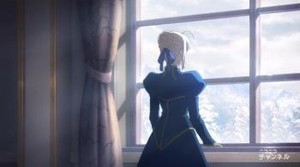
Fate/Zero Episode 2
Rating: 4
Review: With the introductory nonsense out of the way, Fate/Zero shifts its focus to Master/Servant relations and proves itself a worthy, perhaps even superior, successor to its predecessor. Young upstart Waver Velvet has learned that summoning a Servant isn't the shortcut to respect that he hoped it would be. His Servant, burly Rider, is loud and haughty and worse yet, doesn't seem to respect him any more than the bluebloods at the Academy did. What happens when a Master is cowed by his Servant? Elsewhere, the serial murderer who has been preying on locals accidentally summons Caster and finds a kindred spirit in the evil magician. Kiritsugu decides that there is an unbridgeable gulf between himself and Saber, a gulf that Saber herself doesn't understand or even recognize. It will need to be bridged somehow, though. Kotomine is making his first move, and though the workings of his twisted psyche are impossible to fathom, it can't mean anything good for Kiritsugu.
Freed from the restrictions of Fate/stay night's visual novel origins and featuring a cast of scheming adults who know their desires and are willing to act aggressively on them, Fate/Zero practically crackles with possibility. When the Masters finally start clashing, it should be a thrilling ride. For now, though, the series chooses not to act on its possibilities. Instead is takes a little time to get to know its players. Unlike Fate/stay night's Masters, Fate/Zero's tend to be interesting and complicated, and they aren't hidden until the last minute, so there are a variety of Master/Servant dynamics to enjoy. The real game, though, is the same as it's always been: Servant guessing. Yeah it's kind of dumb and geeky, but it's still weirdly addictive trying to puzzle out who the Servants are. Don't be surprised if you find yourself poring over the end credits for clues. In the meantime everything continues to look fantastic, and a brief Servant battle serves up a small taste of what director Ei Aoki is capable of action-wise. If you're hearing an odd chafing noise, that's me rubbing my hands in anticipation.
Fate/Zero is available streaming at NicoNico and Crunchyroll.

Majikoi - Oh! Samurai Girls!
Rating: 2 ½
Review: Forget the title; girls aren't the reason to watch Majikoi. It's the series' focus on military strategy that redeems it. Barely. Still, that's better than no redemption at all. When a dispute at Kawakami Academy cannot be resolved via civilized methods, the parties involved can resolve their differences via mock warfare. Only de-lethalized medieval weapons are allowed, but other than that, anything goes. Alliances, betrayal, hiring of mercenaries—if it's kosher in a real war, it's kosher in the fake one. One side loses when the other captures their leader. Even if the weapons used are phony, the mock battles can still get pretty intense, especially when Kawakami's elite warriors are involved. Yamato isn't one of them. He's never been much of a fighter. He is one heck of a strategist, though. As his misfit class squares off against the larger, better-funded class 2-S, he proves it again and again, outfoxing his opponents at every turn. It's just too bad that the girl he's trying to impress is fighting for the other side.
The battle that is this episode's centerpiece, though inherently a little jokey thanks to the fake weapons and gym shorts, is good stuff. It's chaotic and violent to be sure, but also filled with sneaky little tactics, strategic withdrawals, and all of the scheming and thinking on the fly that you'd expect of a reasonably real battle simulation. You'll never mistake the show for Legend of the Galactic Heroes, but it may be the closest you can get in an adaptation of an adult dating sim. Unfortunately, the battle isn't all there is to the episode. There's also the side-plot about two wandering soldiers (or androids?), which is for now inexplicable; the martial-arts rivalries, which keep interrupting the large-scale battle and are at best dull and at worst embarrassingly overdone; and the romance, which is plain awful. There's also some not-quite-sexual humiliation, played for laughs, that doesn't bode well for the series' progressive credentials. Enjoy it for the warfare, but be aware that it could start sucking at any minute.
Majikoi - Oh! Samurai Girls! is available streaming at Crunchyroll.
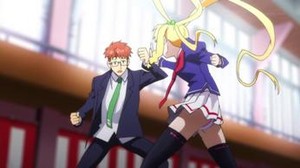
Maken-Ki!
Rating: 1
Review: If it were a crime to waste talent, someone would be strapping Maken-Ki! into the electric chair right now. Nobuteru Yuki's designs have lent their distinctive charm to series as far-ranging as Escaflowne and Paradise Kiss. Yousuke Kuroda spent much of the 90's and 00's penning audacious scripts for series like Infinite Ryvius and Trigun. While not on par with his collaborators, as director, Koichi Ohata has molded series like Burst Angel and Ikki Tousen: Dragon Destiny into towering monuments to trashy fun. Three great talents (okay, two great talents and one decent one), and this is what they give us? This steaming pile of boredom sprinkled with grotesque fan-service and half-hearted fights? Really?
It goes something like this: Takeru is a perverted no-goodnik. His childhood friend Haruko is a beautiful honor student and vice-president of the student council. She's on her way to pick him up, as he has just enrolled at her newly co-ed high school. When she arrives he accidentally molests her and they then head off to school. At school Takeru witnesses a super-powered duel between two female students, watched over by a third, who is obviously some sort of high mucky-muck. After accidentally molesting her, he heads to the opening ceremony. At the ceremony, the mucky-muck tries to kill him but is stopped by a busty babe with a super-special weapon who claims to be his fiancé. Later, the fiancé, mucky-muck and childhood friend move into Takeru's dorm room.
It bears mentioning that the girls are so hugely over-endowed that they're plain gross and that Ohata's up-skirt shots make you yearn for the grace and refinement of Studio Fantasia, but really, that synopsis tells you everything you need to know. If you were to make a mean-spirited spoof of anime, it would likely look a lot like Maken-Ki!. It's as if Kuroda and original creator Hiromitsu Takeda gathered up every dumb, moldy, past-its-prime trope they could imagine and then lumped them together in hopes that something interesting would form. Nothing does. This isn't entertainment; it's an insult—to us, and to the talents wasted on it.
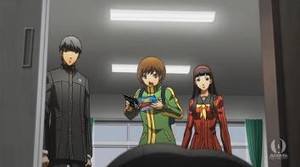
Persona 4: the Animation
Rating: 3
Review: There's a lot going on and little explained in Persona 4's first episode. Unlike, say, Horizon in the Middle of Nowhere, though, Persona is handsome and interesting enough that you may actually stick around to find out what's what. Yu Narukami has recently moved from the big city to a small town, and like any teen in a sleepy new burg, he's bored. But not for long. He starts getting headaches and hearing voices, and not long after he meets his first potential friends, a local celebrity is impaled on a TV antenna. Then things get really weird. While staying up to check out an urban (suburban? rural?) legend about a supernatural television station that is only accessible at midnight, Narukami discovers that he can pass through television screens. Like the bored teens they are, instead running away he and his friends decide to find a TV big enough to fit through. What they find on the other side is a mirror world filled with dangerous "shadows."
Yes, the alternate reality thing is a cop-out designed to excuse the video-game aspects of the show's story (it's based off of one), and yes, we are all tired of small towns with evil secrets boiling beneath their sleepy surfaces, but that's hardly fatal. The series' dry humor and brisk pace ensure that neither rankles (too much), and a surprisingly fun cast keep us engaged even when things aren't very engaging. Narukami's new friends are a bickering not-couple with an enviably easygoing relationship; his uncle, with whom he lives, is a gruffly good natured police detective with the world's most adorable daughter; and even peripheral players like his manic, illogical homeroom teacher and the guy who pumps his gas have personalities that pop out of the screen at you. Narukami is the weak link at first, sleepwalking through the early part of the episode, but his apathy quickly becomes a bit of a joke, and his reaction to alternate-world empowerment is both realistic and funny. Slather some slick visuals on top of that and the series is definitely worth a look—if not necessarily much more.
Persona 4: the Animation is available streaming at The Anime Network.

Boku wa Tomodachi ga Sukunai
Rating: 3 ½
Review: It's amazing what a little tweak can do. What if, instead of romance, the usual school-comedy suspects were in hot pursuit of...friendship? To be fair, Boku wa Tomodachi ga Sukunai has more going for than just that, but the tweak does help. A lot. When Kodaka sees Yozora carrying on an animated conversation with her imaginary friend Tomo, his first thoughts admittedly (and oddly) are of romance. Instead of a girlfriend, though, he finds a kindred spirit. Because of his hair (blonde) and eyes (fierce), Kodaka is considered a dangerous delinquent by his classmates. Yozora is just prickly and hard to like, but the result is the same: neither has any friends. After a quick discussion during which friend-fishing and joining clubs are dismissed, respectively, as shameful and unworkable, Yozora gets an idea: create a club. A friend-making club.
It's a charming premise, outcasts and oddballs banding together to make friends, and one that anyone who struggled with social life in high school can get behind. It comes with a built-in cast of underdogs and plenty of comic, and emotional, potential. It also provides a plot (in a schoolyard comedy? No!) that doesn't by definition treat snagging a hot girl (or guy) as the be-all end-all of adolescence. That's a lot for one little tweak to do. The series still has piles of clichés, of course: the rivalry between the flat-chested girl and her G-cup nemesis, for instance, or the fact that that Kodaka is apparently going to be the only guy in the club. (What, guys don't have trouble finding friends too?) The show has a facility for directing those clichés in just the right direction, though. When Yozora and jiggly rich girl Sena fight, it's with poison tongues and sharp wits, not butting heads and childish tantrums. It also has a fine sense of humor (the flashback to Kodaka's first day is great) and a superior sense of balance, never allowing either its silly or serious sides to run away with it. Perhaps it isn't brilliant, but it has promise. And nice fan-service, which doesn't hurt.

Mashiro-Iro Symphony - The color of lovers
Rating: 2
Review: You know you're in trouble the minute Mashiro-Iro's voiceover starts pondering the color of love. A piano tinkles mournfully, images of nature blend into a montage of the seasons, and disembodied girls' voices wonder "what color are boys? What color are girls? If they meet, what color would their relationship be?" That pretty much sets the tone for the series: atmosphere overload served with heaping helpings of emotional schlock. What follows is the story of one Shingo Uryu. He's a normal guy, maybe nicer than most. The kind of guy who'd run out in the dead of night without a second thought when his sister calls for help. Sakuno, his sister, has a terrible sense of direction and rings him up when it is clear that she's totally lost. Shingo dashes out, but wouldn't you know it, Sakuno's phone battery runs out before he can get a lock on her location. Luckily a similarly lost girl with a working phone happens upon Sakuno, and together they coordinate a rendezvous with Shingo.
All of that is exactly as dull as it sounds. Shingo and his crew couldn't be any duller if they purposely repressed their personalities, and the series is so preoccupied with constructing the melancholy pall that hangs over it that it forgets to have anything actually happen. And when something eventually does, it's inevitably something awful. Like the appearance of the series' hideously deformed mascot animal (it's apparently a living throw-pillow), or the introduction of the various girls/fetishes who will inevitably comprise Uruyu's stable of romantic possibilities. When Shingo goes to school, it naturally turns out that it's a girls' school that is only now being integrated, and guess who's the hostile headmistress's daughter? No prizes for guessing Sakuno's mysterious benefactor. Instant friendship (just add water! Or rain) and cruelly cheesy destined encounters provide what passes for a heart, while the inevitable wacky bit players provide comic relief that is only comic in a relative sense. If sad, atmosphere-first visual novels are your thing, you might survive this, but even then you'd be better served by just watching Kanon (either one) again.

Horizon in the Middle of Nowhere
Rating: 2
Review: In the far future, humanity has lost dominion over the Earth. In order to regain it, they decide to re-enact history. They do so by following something called the Testament. Something went wrong in their re-enactment, however, and everyone in the world was forced to live in the only habitable place left on Earth: Japan. They divided up the land into feudal fiefdoms and promptly set about reliving the Warring States period. The year is now 1648, or at least whatever passes for it in a future simulacrum of history. The residents of the floating city of Musashi are refugees from the original population of Japan, kept perpetually under the thumb of the Testament Union, the authority that runs the re-enactment of history. Among the dirty tactics the Union uses to keep the Musashians in their place is the appointment of idiots to Musashi's Chancellor's seat. Which is how Tori Aoi became Musashi's representative.
It isn't that Horizon is bad; it's just incomprehensible. The show crams so many characters, so much historical and political context, into this first episode that it totally self-destructs. The above is as close as I can get to a synopsis, and yet even having watched the episode twice and read up on the original novels (yay Wikipedia!) I still can't tell you if it's entirely accurate. And that's having left out the really incomprehensible stuff. Like who Horizon is, and how Tori intends to ask her out when she is supposedly dead. Or what the hell the Harmonic Divine States are...or were. (They're referred to as a copy of the "real" Divine States. Whatever that means.) And just to add that special extra level of confusion there are also a slew of characters named yet never shown, and still more that are shown but never named--this on top of Tori's large class, all of whom are introduced during a running PE fight/class. You'll spend so much time scratching your head that there's hardly any time to worry that the characters all seem to be broad stereotypes, that their designs kind of stink, or that the premise of the Testament re-enactment makes no sense at all. Which I guess isn't all bad.
Horizon in the Middle of Nowhere is available streaming at The Anime Network.

Chihayafuru
Rating: 3 ½
Review: In karuta, players listen to the first lines of a poem and compete to grab the remainder of the poem from cards arranged on the ground between them. Thrilling, huh? To make a sports anime from it seems foolhardy, but Chihayafuru has real creative muscle behind it in the form of director Morio Asaka and a firm grasp on the basics of good TV, so don't count it out just yet. High-school knockout Chihaya Ayase is too weird for her looks to do her much good. Stupidly honest and devoid of self-awareness, she tends to scare guys more than attract them. Worse yet, she is obsessively devoted to the unpopular game of karuta. She first encountered the game when she befriended fledging karuta pro Arata in grade school, sparking a lifelong love affair with poetry cards. In high school she and Arata have gone their separate ways, but Chihaya has not given up on reuniting with him via the game they both loved.
When you put it like that, the show really does sound dumb. In actual execution, though, it's anything but. The series knows that characters and their emotions trump card-snatching action any day. Chihaya doesn't make a whole lot of sense until you flash back to see her as a spunky tomboy, before her family's supermodel genes kicked in and transformed her into an adolescent daydream. It's a charming idea, a tomboy trapped in a supermodel's body, and Chihaya doesn't waste it. Asaka lets her charms, along with Arata's magnetic drive and fellow karuta buddy Taichi's repressed affection and total selfishness float easily to the surface, never forcing a point or berating an emotion. The outlines of the trio's relationship—sure to be one of the series’ cornerstones—are crystal clear, yet not once overtly stated. Sure, not everything is perfectly realistic—in any sane world, Chihaya would have to beat suitors off with a stick—but the series still has an easy, natural feel. And the lovely art hurts nothing. Not bad at all.
Chihayafuru is available streaming at Crunchyroll.
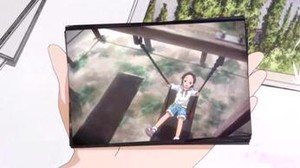
Tamayura - Hitotose
Rating: 3
Review: If you want sweetness and light this season, then you want Tamayura. The latest in Junichi Sato's run of "healing anime," it's as kind and gentle as they get. There is such a thing as too sweet, though, and Tamayura gets dangerously close. The death of her father some time ago devastated young Fu Sawatari, but with the help of her supportive best friend Chihiro she's now starting to get past it. Her father loved photography, and so did she, but after his death it hurt too much to take pictures, so she gave it up. After an eye-opening look at her father's work, though, she decides to take up the camera again. Emboldened, she also decides to move back to her father's hometown to attend high school. Chihiro is sad, but encourages her to go. With her mother and little brother not far behind, Fu sets out to start her new life.
Uplift isn't an easy thing to do right; even harder if you're planning to do it with a terminally gentle slice of life. Sato's done it in the past, though; namely with Aria and its sequels. And he seems to be hitting the right notes here. The atmosphere and the music are beautiful, the pace sleepy without being dull, and the characters all huggably warm (yet still odd enough to be amusing). Even so, something feels kind of off. It may have something to do with the series' sentimentality. It isn't exactly syrupy—photography's inextricable ties to the passage of time and the transience of life add a bittersweet edge of melancholy—but it is overt, even a little crude. There are echoes of Aria throughout the show—the music, the cameo by Erino Hazuki, the impossibly nice cast—but it forgets some of Aria's most basic lessons. Like the importance of location. Aria's impossibly nice characters worked because they fit their world. Tamayura's live in the real world, in which their impossible niceness rings rather false. Still, the series does leave you feeling fuzzy inside, which is better than most manage. Bravo for that, at least.
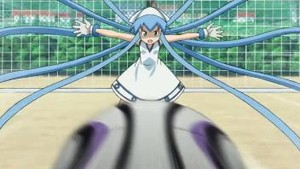
Squid Girl 2 Episode 2
Rating: 3 ½
Review: Episode one highlighted Squid Girl's warmth; episode two brings out its humor. Warmth is fine; heck it's great. But many a fine comedy has succumbed to squishy sentimentality while trying to up its cuddle factor, so it's good to see Squid Girl hardening itself up for some good laughs. Ever open to new experiences, Squid Girl decides that she'll attend grade-school with Takeru. With so many young, impressionable minds around, she decides it's the perfect time to build her anti-litter army. Naturally, this leads to a game of soccer. Afterwards, Eiko and Chizuru decide that what the Lemon beach house really needs is a hot waiter. Nagisa kind of looks like a guy... Later Squid Girl discovers the human obsession with weight loss and the Aizawa sisters decide to weigh their squiddy charge, with decidedly odd results.
True to the first season, this episode's worth of goofing around never ascends to the heights of hilarity, but it is consistently light and funny. Squid Girl makes a mockery of the beautiful game by inspiring her opponents to pity, Chizuru tries to calm a temporary waitress's fear of men by giving her spiked knuckles, and Squid Girl learns that her place in the food chain in the same on land, sea or air. If you can make it through any of that without breaking into a goofy smile, then you're a grumpier man than I. Newbies will want to go back and watch the first season, as the humor is often dependent on established character dynamics, but otherwise this is a comedy that pretty much anyone can enjoy. It's bright, good-natured, and uniformly fun, but never empty or Pollyannaish. The jokes have bite, but never hurt; its characters are nice, but never sappy. The series continues to look surprisingly good and Squid Girl's cuteness is still off the charts, but what makes Squid Girl great is that it's a great place to go for guilt-free fun.
Squid Girl 2 is available streaming at Crunchyroll.

Kimi to Boku (You and Me)
Rating: 2 ½
Review: How do you make another meaningless series about the everyday lives of schoolgirls feel fresh and new? By making the schoolgirls into schoolboys, of course! Yuta, Yuki, Shun and Kaname have been friends since kindergarten. Shun has always been the sensitive one, Kaname the sharp-tongued, responsible one, and twins Yuta and Yuki the asocial, apathetic ones. That hasn't changed, even now that they're seventeen and in high school. Kaname is sharing a class with Yuki for the first time, whose lone-wolf-ness ticks him off, so Kaname decides to get Yuki socialized by enrolling him in a club. As they drag Yuki from club to club, all of which he treats with towering indifference, the four reminisce about their shared past.
And that really is it. If it wasn't for the fact that the four friends at the center of this series were guys, this could be pretty much any of the meandering slices of school life that have been clogging the airwaves of late. It's quiet, sweet-natured, and boring as hell. None of the characters is particularly interesting, nor—with the exception of the nice-to-a-fault Shun—particularly likeable. Their discussions, which occupy a large portion of the episode, are dull and have an oddly un-boylike feel, perhaps because the boys are standing in for the schoolgirls who would usually be having such discussions. The pastel coloring and gentle art are easy on the eyes, and the series' laid-back tone means that it never grates, but you can't help wishing that something, anything, would happen. If future episodes shake up the boys' lazy school lives a bit and maybe give the series' cool, dry sense of humor more to do, this could be a nice diversion. The next episode preview, which appears to be introducing (no!) a girl, is promising, but it pays to be skeptical. Series of this particular stripe thrive on stasis, so hoping for change could well be a fool's errand.
Kimi to Boku is available streaming at Crunchyroll.
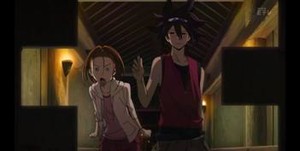
Phi-Brain Puzzle of God
Rating: 3
Review: Making an action-adventure show about solving puzzles is odd for sure, but it's no odder than a lot of what other series try. And Phi-Brain almost makes it work. Almost. When high-school puzzle-freak Kaito Daimon is given a mysterious device by the student body president, he blasts through the little things' store of puzzles in no time flat. After the last one, the device invites him to navigate a very real maze buried beneath the school grounds. After his first foray proves that the maze is potentially deadly, Kaito refuses to re-enter. A puzzle that kills is no puzzle in Kaito's book. With a little manipulation by the president, though, he agrees to go back, this time with spunky gal-pal Nonoha tagging along. Together they hope to do what Kaito couldn't alone: reach the center of the puzzle, where waits a treasure that can unlock the potential of the human mind itself.
Attaching earth-shaking consequences and dark, terminology-laden secrets to the solution of brain-teasers is an inherently silly thing. Watching the president and the principal scheming behind the scenes while speaking of Contracts, Phi Brains, and Divine Puzzles is pretty funny, and Kaito's motivational flashback to the man who inspired his life of puzzle-solving is very nearly hilarious. The series itself doesn't seem to think so though, and treats everything as if it was deadly-serious. Things start to even out, however, once the puzzle-solving starts in earnest. Unfortunately there's no place in Kaito's maze-navigating for us to use our own puzzle-solving skills, but it moves quickly and even manages a pretty respectable balance of suspense and action. Not bad for a glorified children's game. That Nonoha turns out to be more than just dead weight is also a nice surprise, as are the solid visuals. The series is shaky, no doubt, but it has enough promise (and cool Rube Goldberg puzzles) to warrant a couple of more episodes.

C³
Rating: 1 ½
Review: C³ isn't made using a template; it is the template: no elaboration, no imagination, just the same bare-bones plot as every other series about a guy who gets a cute girl sent to him in the mail. Okay, so she's actually a cursed box, which is weird (and convenient for the post office), but the series has no other distinguishing characteristics. Certainly not Haruaki, who is the guy who gets the girl in the mail. Haruaki is curse-resistant and good-natured and not much of anything else, which is good news for Fear, the girl/box whom Haruaki's peripatetic father mails to him. If Haruaki had more personality, he might have actually gotten angry when she destroys his house while trying to clean it. Instead he lets it slide because, well, because he's good-natured. In the meantime Fear bonds with the shopkeepers in the local shopping arcade and spits and hisses at Haruaki's busty, bespectacled childhood friend Konoha.
There's some business about Fear undoing her curse, and a pause here and there to highlight her loneliness, but for the most part this episode is concerned only with cramming in as many dumb romantic comedy clichés as it can. It grinds joylessly through the arrival of the girl, her naked appearance in the hero's kitchen (eating her obligatory signature snack), the new girl vs. childhood friend catfight, the demonstration of shoddy domestic skills, the charming of the locals, and the token fight and reconciliation. For something so frenetic, it's curiously lacking in enthusiasm and even more barren of personality. It's a romantic-comedy blank slate, one that the series seems to have no intention drawing on. The arrival of a nasty-looking lady at the end hints that future episodes might be mixing things up with some action, but if the series approaches action the same way it does romance, that won't help. Shin Oonuma, the series' director, can do better than this; and he should.
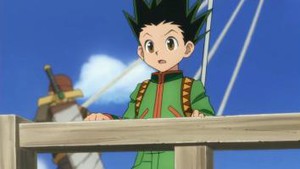
Hunter x Hunter
Rating: 2
Review: Remakes aren't just for Hollywood any more. The anime industry is getting fonder of them by the day, and with Hunter x Hunter proves that it can disrespect the past with the best of them. The story is pretty much the same: Gon Freecss is a happy-go-lucky nature boy living on Whale Island with his loving aunt Mito. He wants to follow in his absent father's footsteps and become a Hunter, an amorphous but difficult occupation that requires rigorous certification, but Mito is firmly opposed. He eventually convinces her, and leaves for the Hunter Test. On the way there he meets fellow Hunter-wannabes Leorio and Kurapica, who join him for the grueling tests ahead.
If there was ever a series that shouldn't have been remade, it was the original Hunter x Hunter. It was only by a miracle of chemistry between director and source material that it didn't end up another shonen sewage plant, and miracles by definition never happen twice. This version is exactly the kind of spunky-kid-following-his-dreams tripe that the original version so artfully avoided becoming. It's inferior to its predecessor in pretty much every imaginable way: the performances are broader, the art duller, the animation shoddier, and the music amateurishly deployed. Even the opening and ending themes kind of suck. It strips away Kazuhiro Furuhashi's gentle lyricism and discards his leisurely pace, in the process losing a lot of the nuance he and his collaborators brought to the plot and characters. Mito loses pretty much all of her back-story and motivation, and her complex love of Gon is steamrolled into something flat and blandly sweet. Leorio and Kurapica are given no space to stretch out and make an impression, and their truncated meeting with Gon robs the trio's union of its fateful feel. The original series was curious in that it always sounded like it should stink, and yet never did. This one, on the other hand, smells exactly like it sounds.
Hunter x Hunter is available streaming at Crunchyroll.
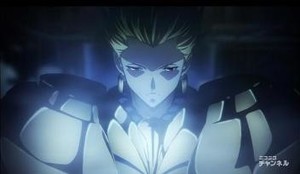
Fate/Zero
Rating: 3 ½
Review: Ever wonder about Rin Tohsaka's family history, or what exactly went down during the Holy Grail War preceding the one Shirou Emiya gets caught up in? Then you're probably going to eat this handsome prequel up with a spoon. Don't know what anything in that first sentence meant? You may not want to start here. Fate/Zero begins as the Holy Grail War looms on the horizon. It is a fierce but secret battle fought every sixty years over possession of a wish-granting artifact known as the Holy Grail. Seven mages are chosen by the Grail as Masters and summon seven Servants—spirits of deceased heroes who will fight one another until only one remains. Masters include Kiritsugu Emiya, an enigmatic ex-killer with an equally enigmatic ambition; Kirei Kotomine, an inscrutable priest with an awesome voice; Tokiomi Tohsaka, the scheming head of an ancient magical lineage; Waver Velvet, a greenhorn out to prove his worth to the Magus Association; and Kariya Matou, an outcast who enters the war to free an innocent girl.
Fate/Zero isn't entirely unkind to the uninitiated; it does a reasonably cogent job of outlining the premise of the Holy Grail War and its Masters and Servants and what have you, and no previous knowledge is necessary to understand the characters or their motivations and interpersonal dynamics. All are concisely and clearly sketched out here in the first episode. To get the full value of the series, though, you really do need to be familiar with the franchise. You need to know that that little girl who chews out Kirei at the episode's end will end up in a deadly battle against him; that Kiritsugu will adopt the orphaned Shirou who will in turn inherit his Servant, Saber; that the Holy Grail War will not end well. It's simple enough to get the gist of the plot and characters, and to enjoy the coldly beautiful atmosphere, but unless you have some connection to where this is all leading, you won't ever understand why the final minutes of this episode send shivers down the faithful's spines.
Fate/Zero is available streaming at NicoNico and Crunchyroll.
discuss this in the forum (641 posts) |
this article has been modified since it was originally posted; see change history
back to The Fall 2011 Anime Preview Guide
Season Preview Guide homepage / archives